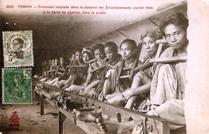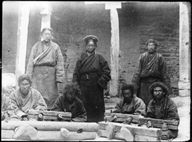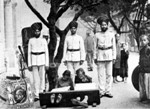A form of pillory used in China for minor offences, the cangue
(also known as the tcha or kea) is described here by the writer
F. Alverez Semedo in his “History of China”:
“It is a great thick board, four or five palme square, with a hole
cut in the middle of it about the bigness of a man’s neck. This
they fasten about their necks, and to it are hung two scrolls of
paper of a hand’s breadth, wherein are written his fault, and the
cause of his punishment; they serve also to show that the
board has not been opened; and so with these great boards
about their necks, these poor wretches are brought out every
day and exposed to shame in the public streets, for fifteen,
twenty or thirty days, according as they are adjudged by their
sentence, whose greatest rigour is that during all that time
these boards are not taken off their necks, neither night or
day.”
"As from the nature of the cangue it is impossible for the wearer to reach his mouth with his hands, he is dependent absolutely for food and drink upon the kindness of others. Those with neither relatives or friends are in sore danger of dying through exhaustion or starvation." (“A History of Torture” by George Riley Scott)
More conventional stocks were also used in China, as the following pictures show.




In these bamboo cages, the victim's neck was secured in stocks. The floor of the cage was
sometimes removed, leaving the victim suspended from the stocks around his or her neck.
